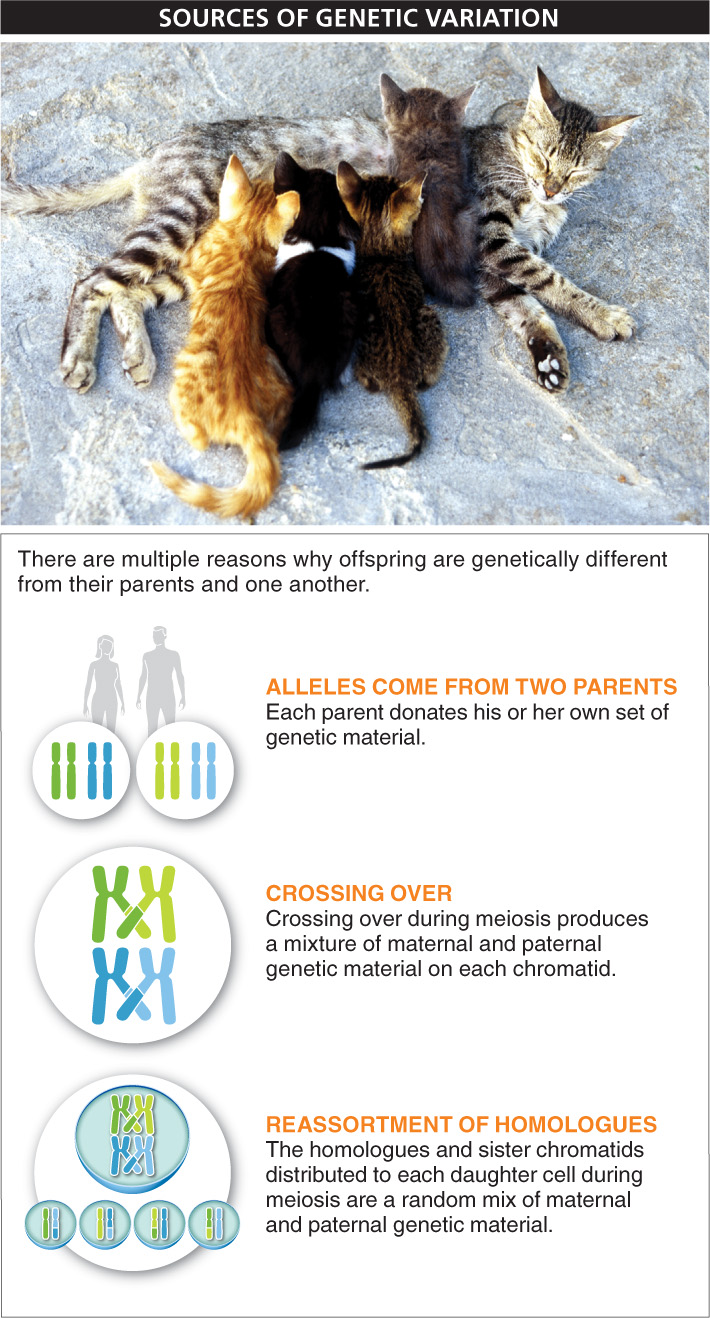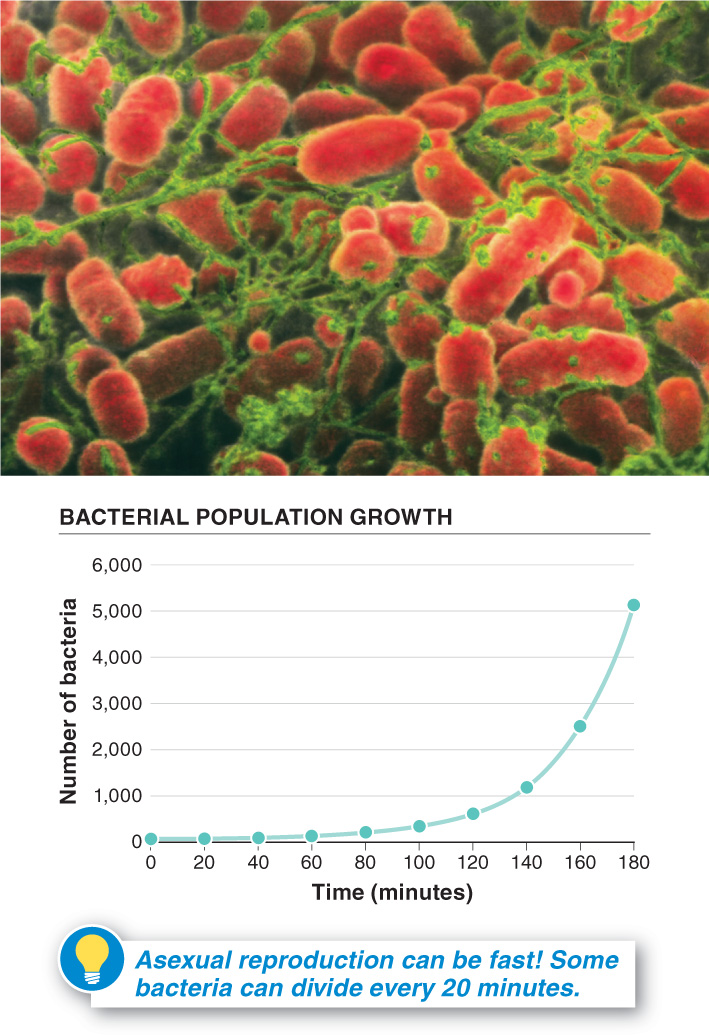
As we’ve seen, there are two fundamentally different ways in which cells and organisms can reproduce. On the one hand, there is mitosis and asexual reproduction through binary fission, fragmentation, or vegetative processes; on the other hand, there is meiosis and sexual reproduction. Is one method better than the other? It depends. In fact, the more appropriate question is, what are the advantages and disadvantages of each method and under what conditions do the benefits outweigh the costs?
What Are the Advantages of Sexual Reproduction? Sexual reproduction leads to offspring that are genetically different from one another and from either parent, through three different routes (FIGURE 6-28).
- 1. Combining alleles from two parents at fertilization. First and foremost, with sexual reproduction, a new individual comes from the fusion of gametes from two different individuals. Each of these parents comes with his or her own unique set of genetic material.
- 2. Crossing over during the production of gametes. As we saw, crossing over during prophase I of meiosis causes every chromosome in a gamete to carry a mixture of an individual’s maternal and paternal genetic material.
- 3. Shuffling and reassortment of homologues during meiosis. Recall that as the homologues for each chromosome are pulled to opposite poles of the cell during the first division of meiosis, maternal and paternal homologues are randomly pulled to each pole. This means that there is an extremely large number of different combinations of maternal and paternal homologues that could end up in each gamete.
Bacteria reproduce asexually, whereas most plants and animals reproduce sexually. Is either method better than the other?
The variability among the offspring produced by sexual reproduction enables populations of organisms to cope better with changes in their environment. After all, if the environment is gradually changing from one generation to the next, individuals producing many genetically different offspring increase the likelihood that one of their offspring will carry a set of genes particularly suited to the new environment. Over time, populations of sexually reproducing organisms can quickly adapt to changing environments. It’s like buying different lottery tickets—
What Are the Disadvantages of Sexual Reproduction? In the yellow dung fly (Scathophaga stercoraria), males sometimes wrestle each other for mating access to a female. The female awaits the outcome of the battle in a pile of dung. Occasionally, females drown in the dung pile as they wait. Males, too, can be at risk during reproduction. This is seen most dramatically in species such as praying mantises and black widow spiders, in which the female will attempt to eat the male (and often succeed in doing so) during or after mating, gaining not just gametes but a nutritious meal as well (FIGURE 6-29)!
29

Dangers associated with mating are just one of the downsides to sexual reproduction. There are several others. First, when an individual reproduces, only half of its offspring’s alleles will come from that organism. The other half will come from the other parent. With asexual reproduction, an individual produces nearly identical offspring, so there is a very efficient transfer of genetic information from one generation to the next. Second, with sexual reproduction it takes time and energy to find a partner. This is energy that asexual organisms can devote to additional reproduction. Third, as we see with the dung flies, sex can be a risky proposition because organisms make themselves vulnerable to predation, disease, and other calamities during mating and reproduction. And finally, as we’ll see later in this chapter, the complex cellular division required for sexual reproduction offers opportunities for mistakes, sometimes leading to chromosomal disorders.
What Are the Advantages of Asexual Reproduction? With asexual reproduction, the advantages and disadvantages are more or less reversed. Because asexual reproduction involves only a single individual, it can be fast and easy. Some bacteria can divide, forming a new generation, every 20 minutes (FIGURE 6-30). And for organisms in isolated habitats or when establishing new populations, asexual reproduction can be advantageous as well. Asexual reproduction is efficient, too. Offspring carry all of the genes that their parent carried—

What Are the Disadvantages of Asexual Reproduction? The downside to asexual reproduction is that the more closely an offspring’s genome resembles its parent’s, the less likely it is that the offspring will be suited to the environment when it changes.
In the end, we still see large numbers of species that reproduce asexually and large numbers that reproduce sexually. It seems that conditions favoring each occur in the great diversity of habitats in the world. That we see both sexual and asexual reproduction also highlights the recurring theme in biology that there often is more than one way to solve a problem.
TAKE-HOME MESSAGE 6.13
There are two fundamentally different ways that cells and organisms can reproduce: (1) mitosis and asexual reproduction, and (2) meiosis and sexual reproduction. Asexual reproduction can be fast and efficient, but it leads to genetically identical offspring that carry all of the genes that their parent carried, which could be disadvantageous in a changing environment. Sexual reproduction leads to offspring that are genetically different from one another and from either parent, but it takes more time and energy and can be risky.
What is the key advantage of asexual reproduction? What is the key advantage of sexual reproduction?
Asexual reproduction is fast and easy, and the resulting offspring carry all of the genes of the parent. Sexual reproduction increases genetic variation in a population, which allows populations to better adapt to a changing environment.
30